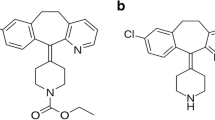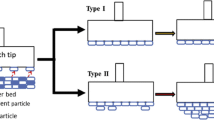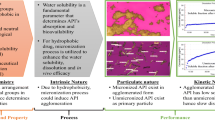ABSTRACT
Purpose
The molecular basis of crystal surface adhesion leading to sticking was investigated by exploring the correlation of crystal adhesion to oxidized iron coated atomic force microscope (AFM) tips and bulk powder sticking behavior during tableting of two morphologically different crystals of a model drug, mefenamic acid (MA), to differences in their surface functional group orientation and energy.
Methods
MA was recrystallized into two morphologies (plates and needles) of the same crystalline form. Crystal adhesion to oxidized iron coated AFM tips and bulk powder sticking to tablet punches was assessed using a direct compression formulation. Surface functional group orientation and energies on crystal faces were modeled using Accelrys Material Studio software.
Results
Needle-shaped morphology showed higher sticking tendency than plates despite similar particle size. This correlated with higher crystal surface adhesion of needle-shaped morphology to oxidized iron coated AFM probe tips, and greater surface energy and exposure of polar functional groups.
Conclusions
Higher surface exposure of polar functional groups correlates with higher tendency to stick to metal surfaces and AFM tips, indicating involvement of specific polar interactions in the adhesion behavior. In addition, an AFM method is identified to prospectively assess the risk of sticking during the early stages of drug development.









Similar content being viewed by others
Abbreviations
- AFM:
-
Atomic force microscopy
- API:
-
Active pharmaceutical ingredient
- EtOH:
-
Ethanol
- MA:
-
Mefenamic acid
- PoF:
-
Pull-off-force
- PSD:
-
Particle size distribution
- PXRD:
-
Powder X-ray diffraction
- SEM:
-
Scanning electron microscopy
- THF:
-
Tetrahydrofuran
- XRD:
-
X-ray diffraction
REFERENCES
Nada AH, Al-Saidan SM, Mueller BW. Crystal modification for improving the physical and chemical properties of ibuprofen. Pharm Technol. 2005;29:90–4. 100–1.
Rasenack N, Muller BW. Ibuprofen crystals with optimized properties. Int J Pharm. 2002;245:9–24.
Rasenack N, Muller BW. Properties of ibuprofen crystallized under various conditions: a comparative study. Drug Dev Ind Pharm. 2002;28:1077–89.
Nokhodchi A, Bolourtchian N, Dinarvand R. Crystal modification of phenytoin using different solvents and crystallization conditions. Int J Pharm. 2003;250:85–97.
Beckmann W. Nucleation phenomena during the crystallization and precipitation of Abecarnil. J Cryst Growth. 1999;198/199:1307–14.
Wang WS, Aggarwal MD, Choi J, Gebre T, Shields AD, Penn BG, et al. Solvent effects and polymorphic transformation of organic nonlinear optical crystal L-pyroglutamic acid in solution growth processes. I. Solvent effects and growth morphology. J Cryst Growth. 1999;198/199:578–82.
Holmback X, Rasmuson AC. Size and morphology of benzoic acid crystals produced by drowning-out crystallization. J Cryst Growth. 1999;198/199:780–8.
Braybrook AL, Heywood BR, Karatzas P. An experimental investigation of crystal/solvent interactions in the copper (II) acetate monohydrate/propan-1-ol system. J Cryst Growth. 2002;244:327–32.
Heng JY, Bismarck A, Lee AF, Wilson K, Williams DR. Anisotropic surface chemistry of aspirin crystals. J Pharm Sci. 2007;96:2134–44.
Heng JY, Bismarck A, Williams DR. Anisotropic surface chemistry of crystalline pharmaceutical solids. AAPS PharmSciTech. 2006;7:84.
Danesh A, Connell SD, Davies MC, Roberts CJ, Tendler SJ, Williams PM, et al. An in situ dissolution study of aspirin crystal planes (100) and (001) by atomic force microscopy. Pharm Res. 2001;18:299–303.
Eve JK, Patel N, Luk SY, Ebbens SJ, Roberts CJ. A study of single drug particle adhesion interactions using atomic force microscopy. Int J Pharm. 2002;238:17–27.
Bunker M, Zhang J, Blanchard R, Roberts CJ. Characterising the surface adhesive behavior of tablet tooling components by atomic force microscopy. Drug Dev Ind Pharm. 2011;37:875–85.
Wang JJ, Li T, Bateman SD, Erck R, Morris KR. Modeling of adhesion in tablet compression--I. Atomic force microscopy and molecular simulation. J Pharm Sci. 2003;92:798–814.
Adam A, Schrimpl L, Schmidt PC. Some physicochemical properties of mefenamic acid. Drug Dev Ind Pharm. 2000;26:477–87.
Software SHELXTL. Bruker AXS Inc., Madison, WI; 1998.
Altomare A, Cascarano G, Giacovazzo C, Guagliardi A. Completion and refinement of crystal structures with SIR92. J Appl Crystallogr. 1993;26:343–50.
Sheldrick G. A short history of SHELX. Acta Crystallogr A. 2008;64:112–22.
Cambridge Structure Database (CSD). Cambridge Crystallographic Data Centre. http://www.ccdc.cam.ac.uk/products/csd/ (accessed August 29, 2012).
Enright TP, Hagaman D, Kokoruz M, Coleman N, Sidorenko A. Gradient and patterned polymer brushes by photoinitiated “grafting through” approach. J Polym Sci, Part B: Polym Phys. 2010;48:1616–22.
Okado J, Okada K, Ishiyama A, Setsuhara Y, Takenaka K. Corrosion resistance of plasma-oxidized stainless steel. Surf Coat Technol. 2008;202:5595–8.
Syed AA, Denoirjean A, Fauchais P, Labbe JC. On the oxidation of stainless steel particles in the plasma jet. Surf Coat Technol. 2006;200:4368–82.
Donik C, Kocijan A, Grant JT, Jenko M, Drenik A, Pihlar B. XPS study of duplex stainless steel oxidized by oxygen atoms. Corros Sci. 2009;51:827–32.
McConnell JF, Company FZ. N-(2,3-Xylyl)anthranilic acid, C15H15NO2. Mefenamic acid. Cryst Struct Commun. 1976;5:861–4.
York P, Ticehurst MD, Osborn JC, Roberts RJ, Rowe RC. Characterization of the surface energetics of milled dl-propranolol hydrochloride using inverse gas chromatography and molecular modeling. Int J Pharm. 1998;174:179–86.
Mayo SL, Olafson BD, Goddard III WA. DREIDING: a generic force field for molecular simulations. J Phys Chem. 1990;94:8897–909.
Berkovitch-Yellin Z. Toward an ab initio derivation of crystal morphology. J Am Chem Soc. 1985;107:8239–53.
Brunsteiner M, Price SL. Morphologies of organic crystals: sensitivity of attachment energy predictions to the model intermolecular potential. Cryst Growth Des. 2001;1:447–53.
Cuppen HM, Day GM, Verwer P, Meekes H. Sensitivity of morphology prediction to the force field: paracetamol as an example. Cryst Growth Des. 2004;4:1341–9.
Prakongpan S, Nagai T. Pharmaceutical interactions in dosage forms and processing. XLV. Solubility of acetaminophen in cosolvents. Chem Pharm Bull. 1984;32:340–3.
Di Martino P, Censi R, Malaj L, Capsoni D, Massarotti V, Martelli S. Influence of solvent and crystallization method on the crystal habit of metronidazole. Cryst Res Technol. 2007;42:800–6.
Romero S, Escalera B, Bustamante P. Solubility behavior of polymorphs I and II of mefenamic acid in solvent mixtures. Int J Pharm. 1999;178:193–202.
Kakimi K, Niwa T, Danjo K. Influence of compression pressure and velocity on tablet sticking. Chem Pharm Bull. 2010;58:1565–8.
Roberts M, Ford JL, MacLeod GS, Fell JT, Smith GW, Rowe PH, et al. Effect of punch tip geometry and embossment on the punch tip adherence of a model ibuprofen formulation. J Pharm Pharmacol. 2004;56:947–50.
Roberts M, Ford JL, MacLeod GS, Fell JT, Smith GW, Rowe PH, et al. Effect of lubricant type and concentration on the punch tip adherence of model ibuprofen formulations. J Pharm Pharmacol. 2004;56:299–305.
Roberts M, Ford JL, MacLeod GS, Fell JT, Smith GW, Rowe PH. Effects of surface roughness and chrome plating of punch tips on the sticking tendencies of model ibuprofen formulations. J Pharm Pharmacol. 2003;55:1223–8.
Kim JS, Lotz B, Lindrud M, Girard KP, Moore T, Nagarajan K, et al. Control of the particle properties of a drug substance by crystallization engineering and the effect on drug product formulation. Org Process Res Dev. 2005;9:894–901.
Yin SX and Grosso JA. Selecting and Controlling API Crystal Form for Pharmaceutical Development: Strategies and Processes. Curr Opin Drug Discovery Develop. 2008;11:771–7.
Docherty R, Clydesdale G, Roberts KJ, Bennema P. Application of Bravais-Friedel-, I Donnay-Harker, attachment energy I and king models to predicting and understanding the morphology of molecular crystals. J Phys D: Appl Phys. 1991;24:89–99.
Clydesdale G, Roberts KJ, Telfer GB, Saunders VR, Pugh D, Jackson RA, et al. Prediction of the polar morphology of sodium chlorate using a surface-specific attachment energy model. J Phys Chem B. 1998;102:7044–9.
Podczeck F. Investigations into the reduction of powder adhesion to stainless steel surfaces by surface modification to aid capsule filling. Int J Pharm. 1999;178:93–100.
ACKNOWLEDGMENTS AND DISCLOSURES
Authors thank David Wantuch and Anisha Patel for their help with PXRD; Michael Galella for single crystal X-ray diffraction analysis; Eric Chan for surface energy calculations; Nigora Issamidinova and Mario Hubert for PSD and SEM analyses; and Lynn DiMemmo and Sarah DeLeon for SEM.
Author information
Authors and Affiliations
Corresponding author
Rights and permissions
About this article
Cite this article
Waknis, V., Chu, E., Schlam, R. et al. Molecular Basis of Crystal Morphology-Dependent Adhesion Behavior of Mefenamic Acid During Tableting. Pharm Res 31, 160–172 (2014). https://doi.org/10.1007/s11095-013-1149-6
Received:
Accepted:
Published:
Issue Date:
DOI: https://doi.org/10.1007/s11095-013-1149-6




